
A tractor is an engineering vehicle specifically designed to deliver a high tractive effort at slow speeds, for the purposes of hauling a trailer or machinery such as that used in agriculture, mining or construction. Most commonly, the term is used to describe a farm vehicle that provides the power and traction to mechanize agricultural tasks, especially tillage, and now many more. Agricultural implements may be towed behind or mounted on the tractor, and the tractor may also provide a source of power if the implement is mechanised.

A skid loader, skid-steer loader, SSL, or skidsteer is any of a class of compact heavy equipment with lift arms that can attach to a wide variety of buckets and other labor-saving tools or attachments.

A shovel is a tool used for digging, lifting, and moving bulk materials, such as soil, coal, gravel, snow, sand, or ore.

Excavators are heavy construction equipment consisting of a boom, dipper, bucket and cab on a rotating platform known as the "house". The house sits atop an undercarriage with tracks or wheels. They are a natural progression from the steam shovels and often mistakenly called power shovels, as power shovels may have similar looking buckets. All movement and functions of a hydraulic excavator are accomplished through the use of hydraulic fluid, with hydraulic cylinders and hydraulic motors. Due to the linear actuation of hydraulic cylinders, their mode of operation is fundamentally different from cable-operated excavators, which use winches and steel ropes to accomplish the movements.
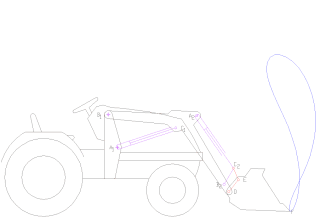
A loader is a heavy equipment machine used in construction to move or load materials such as soil, rock, sand, demolition debris, etc. into or onto another type of machinery.

A backhoe—also called rear actor or back actor—is a type of excavating equipment, or digger, consisting of a digging bucket on the end of a two-part articulated arm. It is typically mounted on the back of a tractor or front loader, the latter forming a "backhoe loader". The section of the arm closest to the vehicle is known as the boom, while the section that carries the bucket is known as the dipper, both terms derived from steam shovels. The boom, which is the long piece of the backhoe arm attached to the tractor through a pivot called the king-post, is located closest to the cab. It allows the arm to pivot left and right, typically through a range of 180 to 200 degrees, and also enables lifting and lowering movements.
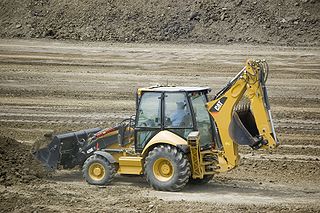
A backhoe loader, also called a loader backhoe, loader excavator, tractor excavator, digger or colloquially shortened to backhoe within the industry, is a heavy equipment vehicle that consists of a tractor-like unit fitted with a loader-style shovel/bucket on the front and a backhoe on the back. Due to its (relatively) small size and versatility, backhoe loaders are very common in urban engineering and small construction projects as well as developing countries. This type of machine is similar to and derived from what is now known as a TLB (Tractor-Loader-Backhoe), which is to say, an agricultural tractor fitted with a front loader and rear backhoe attachment.

Heavy equipment, heavy machinery, earthmovers, construction vehicles, or construction equipment, refers to heavy-duty vehicles specially designed to execute construction tasks, most frequently involving earthwork operations or other large construction tasks. Heavy equipment usually comprises five equipment systems: the implement, traction, structure, power train, and control/information.
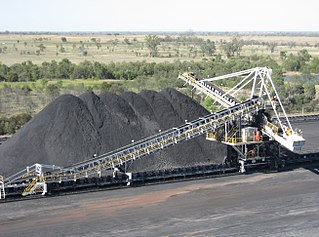
A stacker is a large machine used in bulk material handling. Its function is to pile bulk material such as limestone, ores, coal and cereals on to a stockpile. A reclaimer can be used to recover the material.

A bucket-wheel excavator (BWE) is a large heavy equipment machine used in surface mining.

A trencher is a piece of construction equipment used to dig trenches, especially for laying pipes or electrical cables, for installing drainage, or in preparation for trench warfare. Trenchers may range in size from walk-behind models, to attachments for a skid loader or tractor, to very heavy tracked heavy equipment.
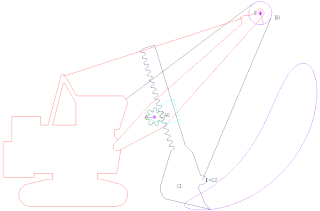
A power shovel, also known as a motor shovel, stripping shovel, front shovel, mining shovel or rope shovel, is a bucket-equipped machine usually powered by steam, diesel fuel, gasoline or electricity and used for digging and loading earth or fragmented rock and for mineral extraction. Power shovels are a type of rope/cable excavator, where the digging arm is controlled and powered by winches and steel ropes, rather than hydraulics like in the modern hydraulic excavators. Basic parts of a power shovel include the track system, cabin, cables, rack, stick, boom foot-pin, saddle block, boom, boom point sheaves and bucket. The size of bucket varies from 0.73 to 53 cubic meters.

Takeuchi Mfg. Co., Ltd. is a Japanese heavy construction machinery company that manufactures excavators, track loaders, crawler dumpers and wheel loaders. Takeuchi was founded in 1963 by Akio Takeuchi as a construction equipment manufacturer. Takeuchi developed the world’s first compact excavator in 1971. In 1986 Takeuchi introduced the compact track loader, another world first. These two products have transformed the global construction equipment markets and have become popular among rental and construction/utility companies. The company has wholly owned subsidiary facilities in the United States (1979), United Kingdom (1996), France (2000) and China (2006). Takeuchi has manufacturing plants in Japan, China and the United States, as well as many distributors around the world.

A tiltrotator is a hydraulic attachment/tool used on most excavators, and backhoes between 1,5 and 40 tons in the Nordic countries. A tiltrotator is mounted on the excavator such that the excavator bucket can be rotated through 360 degrees and one tilts +/- 45 degrees, in order to increase the flexibility and precision of the excavator. The Tiltrotator was introduced to the market in Sweden in the early 1980s by the Norgrens under the family owned and operated company named Noreco, and has become the standard in Scandinavia. The concept has recently gained popularity in other countries such as the Netherlands, Germany, UK, Japan, Canada and United States.
Excavator controls specifies ways of how a human operator controls the digging components of a piece of heavy machinery, such as a backhoe or an excavator.
ENMTP is an Algerian company specializing in the development, manufacture and distribution of machinery used in public works. It has registered capital of 15.6 billion DA and is 100% owned by the state.
An auxiliary hydraulic system delivers pressurized hydraulic fluid from a hydraulic pump to operate auxiliary equipment or attachments. The addition of an auxiliary hydraulic system to heavy construction equipment increases the versatility of the vehicle by allowing it to perform additional functions with different attachments.
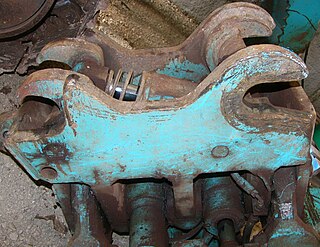
Quick couplers are used with construction machines to allow the rapid change of buckets and attachments on the machine. They remove the need to use hammers to manually drive out and insert the mounting pins for attachments. They also bring with them additional safety risks that must be overcome by careful design and manufacture, and proper use.

A walking excavator or popularly spider excavator is a special type of all-terrain excavator. Like the regular excavator it consists of a boom, stick, bucket and cab on a rotating platform known as the "house". However, its house sits atop an undercarriage consisting of leg or arm-like extensions with or without wheels. All extensions can move in increments, hence the name walking excavator. This is different from an early 20th century dragline excavator where a set of feet plate are alternately lifted and lowered.

Digging, also referred to as excavation, is the process of using some implement such as claws, hands, manual tools or heavy equipment, to remove material from a solid surface, usually soil, sand or rock on the surface of Earth. Digging is actually the combination of two processes, the first being the breaking or cutting of the surface, and the second being the removal and relocation of the material found there. In a simple digging situation, this may be accomplished in a single motion, with the digging implement being used to break the surface and immediately fling the material away from the hole or other structure being dug.






















